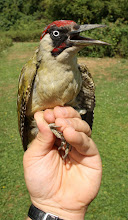Ringing at my trainers house this morning including:
House Sparrows (several juveniles)
Chaffinches
Starlings
Goldfinches
Greenfinches
Blue Tit
Great Tit
It was a chance to see birds I don't normally see in good numbers (mainly House Sparrow, Chaffinches & Goldfinches). No photographs this time.
Sunday 29 June 2008
HAPPY BIRTHDAY MARK
My little brother is 28 now. Happy Birthday Bro. Hope you had a good weekend at a muddy Glastonbury!
Love from this ugly git:

Love from this ugly git:
Priory Country Park (28/06/08)
A morning of Constant Effort at Priory Country Park produced several youngsters of different species (as it should be at this time of year). It wasn't a bad morning.

Above: A Jenny Wren hiding her modesty!
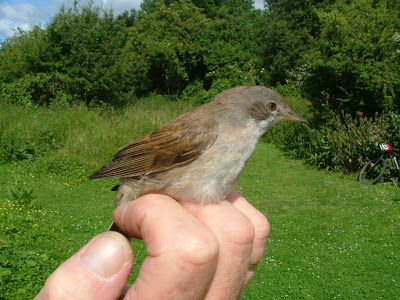
Above: A Common Whitethroat. I like this photo as it shows a striking brown patch underneath the eye.

Above: A Song Thrush.
Above: A Jenny Wren hiding her modesty!
Above: A Common Whitethroat. I like this photo as it shows a striking brown patch underneath the eye.
Above: A Song Thrush.
Yet more birds by Thorburn
Tuesday 24 June 2008
They'll Tern me mad!
Tuesday 24/06/08. After a 10 mile cycle ride to Broom Gravel Pits (briefly following a Jay near my house), I ringed some Black Backed Gulls and some Common Terns. An enjoyable evening with a 10 mile cycle ride home (taking in a view of a little owl).
Above: A Black Headed Gull juvenile (note the poop on my trousers - a common occurance).
Above: A juvenile Common Tern that has started getting its 'grown up' plumage.
Above: The 'creche.' You can compare the juvenile Common Terns side by side. The older one on the right & the younger one on the left. The one on the left is still in the camouflage stage while the one on the right is growing its proper feathers.
Above: The rings I put on this bird. On the right leg, the BTO ring (silver) is above the white ring. On the left leg, the dark blue ring is above the yellow ring. This uniquely identifies this bird if somebody sees it somewhere else in the world while in the field! You can compare this to another common tern I ringed and posted the photo (to compare, check other posts including the archive at the bottom of the page).
Sunday 22 June 2008
New Gull Species Part 3
Above: This would be my first Lesser Black Backed Gull too.
Above: Another LBB Gull.
Above: The herd of LBB & Hering Gull juveniles.
Above: This would be my first Hering Gull. If it looks identical to the photo of the LBB Gull at the top of this post, that's because it is very difficult to tell them apart. You would have to look at the primary feathers on the wing to be able to tell the difference & that would be how I know this is a Hering Gull.
Above: The middle of the doughnut!
New Gull Species Part 2
Above: This is what the gulls do when you invade their breeding area!
Above: Gulls in the air (because of the strong winds, the gulls did not waste much energy flapping about - the wind helps them hover (well as near as).
Above: The surprise of the day. An Eider duck more commonly found much (much, much, much) further north than Norfolk at this time of year. Maybe I will get to ring one sometime in the future (too good to resist taking a photo though).
Above: Part of the colony (adults and juveniles) before the round up begins.
Above: What can this be? A ring? It even has an inscription on it! Fancy that. I think I recognise my hand too! Must have been the first Lesser Black Backed Gull I ever ringed then.
2 New Gull Species Part 1
Today (22/06/08) has been a long day. Thankfully it didn't start early (as most of my bird ringing does). A respectable 9.30am pick up time. A few hours later I was at a lovely place in Norfolk near Kings Lynn where The River Nene & The Great Ouse come out into the washes. A quick lunch, a short & amusing drive with locked gates (& no keys), humongous pot holes in the tracks and bemused walkers wondering how 4 cars could be found in a place cars aren't supposed to be! The view was good.

Above: You can just about make out the destination point in the middle of the horizon.

Above: Using the zoom, this is the destination point. It is in the shape of a Doughnut to collect water for piping elsewhere and is supposed to be a Ted Heath initiative. No surprise it didn't work out! It is now home to a huge colony of Lesser Black Back & Hering Gulls. Gulls are too big & boisterous for other birds to call this place home tweet home!
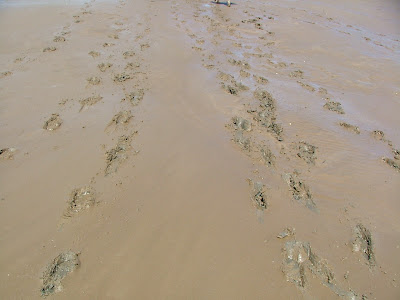
Above: The mud we had to walk through to get there!
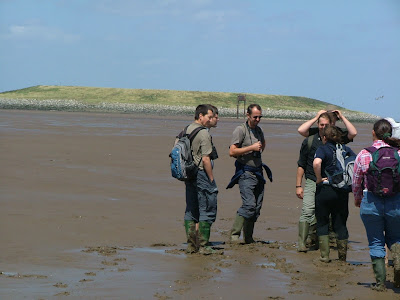
Above: A gathering before we invade the island!
Above: You can just about make out the destination point in the middle of the horizon.
Above: Using the zoom, this is the destination point. It is in the shape of a Doughnut to collect water for piping elsewhere and is supposed to be a Ted Heath initiative. No surprise it didn't work out! It is now home to a huge colony of Lesser Black Back & Hering Gulls. Gulls are too big & boisterous for other birds to call this place home tweet home!
Above: The mud we had to walk through to get there!
Above: A gathering before we invade the island!
Wednesday 18 June 2008
New RSPB badges
In the post today were some badges. Strange that - one would think I had donated some money to the RSPB in return for these badges. Oh ... wait ... I did. These are the remaining International badges (rook, saker falcon & Stork) that they put on backing cards especially for the collectors group. Also included was the (only just released) Official Pin Badge Collectors Group badge featuring a magpie. Only 500 of these were made & are for group members only.
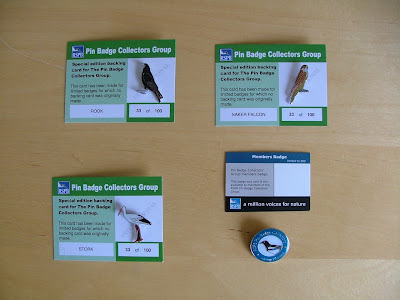
More Birds by Thorburn
I have recently discovered that Archibald Thorburn was a well known (early 20th Century) artist well known for painting birds. I have a few puzzles (as you may have seen) now that depict Birds by Thorburn. The birds are done in great detail and are very accurate - including size, shape etc. which is very difficult to do. I am rarely interested in art but I shall be exploring this work more.

Above: The completed puzzle. I particularly like the way birds are grouped together to make the picture more interesting.
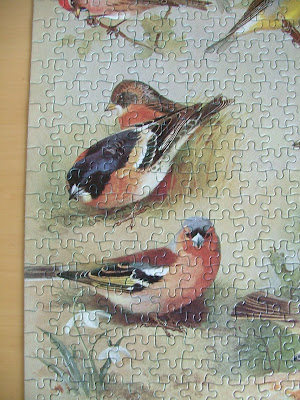
Above: A male chaffinch to compare with a male brambling (summer + winter plumage).
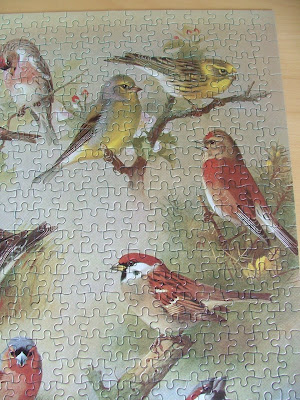
Above: Here you can see a Mealy Redpoll (top left), A Citril Finch (top middle) a Serin (Top right), a Linnet (middle right) and a Tree Sparrow (bottom).
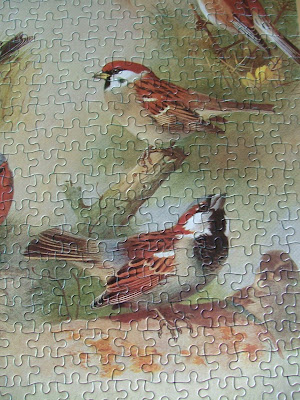
Above: You can compare a Tree Sparrow (top) with a male House Sparrow (bottom). You can just about see the outline of a female House Sparrow (bottom right).
Archibald Thorburn originally published his drawings in a book (4 volumes). I found somebody on the internet selling the set (2nd edition) for £600! I think I will have to buy prints if I want to put any in frames on my wall!
In my opinion (humble as it is) most art wouldn't be worth displaying. Just occasionally, though, you find something that is. And this won't be the last time you see a post with Birds by Thorburn on this Blog!
Above: The completed puzzle. I particularly like the way birds are grouped together to make the picture more interesting.
Above: A male chaffinch to compare with a male brambling (summer + winter plumage).
Above: Here you can see a Mealy Redpoll (top left), A Citril Finch (top middle) a Serin (Top right), a Linnet (middle right) and a Tree Sparrow (bottom).
Above: You can compare a Tree Sparrow (top) with a male House Sparrow (bottom). You can just about see the outline of a female House Sparrow (bottom right).
Archibald Thorburn originally published his drawings in a book (4 volumes). I found somebody on the internet selling the set (2nd edition) for £600! I think I will have to buy prints if I want to put any in frames on my wall!
In my opinion (humble as it is) most art wouldn't be worth displaying. Just occasionally, though, you find something that is. And this won't be the last time you see a post with Birds by Thorburn on this Blog!
Sunday 15 June 2008
Terns & Gulls Part 2
Following on from Part 1, I have a few more photographs to show you.
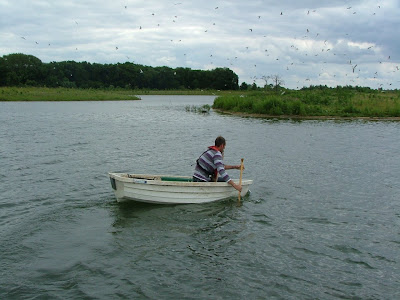
Above: Our method of transport. I still got my feet wet by chasing after juveniles that had got into the water.

The one Common Tern that I ringed today. This year, the terns were colour ringed to identify individual birds. On the right leg, the BTO metal ring (that gives the bird a unique number) sits on the leg above the white (plastic) ring. On the left leg, the white ring sits above the black ring. It is possible to have many different ring combinations. Which leg the rings are on & their combination (e.g. white on top of black) helps BTO (British Trust for Ornithology who are informed about sightings) identify the group of birds which an individual came from or (in this case) a specific individual. This means that with binoculars/telescopes, people can identify a ringed bird & pass the information on without having to recapture the bird. A huge advantage.
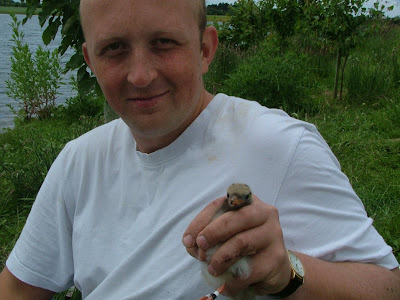
Above: Me and the Common Tern
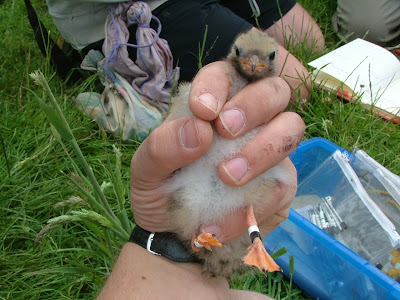
Above: Again, me and the Common Tern with the rings on it. I am holding the bird in the 'ringers grip.' The Common Terns are smaller than the black headed gulls and they also have a white front.
Above: Our method of transport. I still got my feet wet by chasing after juveniles that had got into the water.
The one Common Tern that I ringed today. This year, the terns were colour ringed to identify individual birds. On the right leg, the BTO metal ring (that gives the bird a unique number) sits on the leg above the white (plastic) ring. On the left leg, the white ring sits above the black ring. It is possible to have many different ring combinations. Which leg the rings are on & their combination (e.g. white on top of black) helps BTO (British Trust for Ornithology who are informed about sightings) identify the group of birds which an individual came from or (in this case) a specific individual. This means that with binoculars/telescopes, people can identify a ringed bird & pass the information on without having to recapture the bird. A huge advantage.
Above: Me and the Common Tern
Above: Again, me and the Common Tern with the rings on it. I am holding the bird in the 'ringers grip.' The Common Terns are smaller than the black headed gulls and they also have a white front.
Terns & Gulls Part 1
Today (15/06/08) saw me cycling about 12 miles to get to Broom Gravel Pits where a group of us invaded Peacocks Island. We were aiming to catch a load of Black Headed Gull and Common Tern juveniles (and whatever else happened to be around).
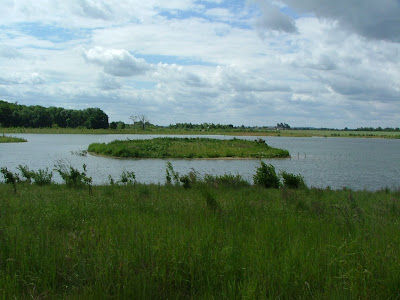
Above: Peacock's Island
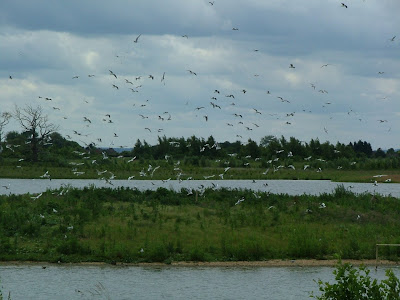
Above: All at once, the adults jumped up into the air as soon as they saw a boat with three people in it coming directly towards them! They all started calling & many stayed up in the air & making a racket for all the time we were there. Well, they were upset!
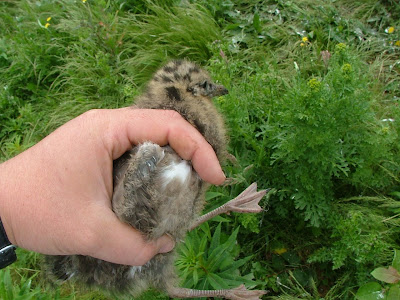
Above: One of my finds - a Black Headed Gull juvenile. It was hidden in amongst the ragwort/thistles etc that were growing on the island. A lot of the birds were difficult to spot.
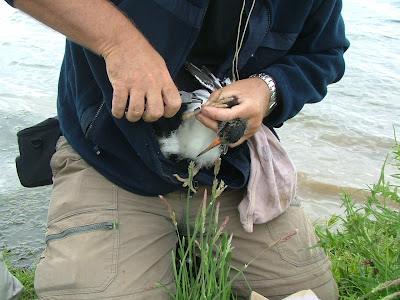
Above: One lucky ringer got to ring this juvenile Oystercatcher. Not me :0(. Another time perhaps.
Above: Peacock's Island
Above: All at once, the adults jumped up into the air as soon as they saw a boat with three people in it coming directly towards them! They all started calling & many stayed up in the air & making a racket for all the time we were there. Well, they were upset!
Above: One of my finds - a Black Headed Gull juvenile. It was hidden in amongst the ragwort/thistles etc that were growing on the island. A lot of the birds were difficult to spot.
Above: One lucky ringer got to ring this juvenile Oystercatcher. Not me :0(. Another time perhaps.
Plovers Jigsaw
Another Wentworth Jigsaw started and completed. This time it was Plovers - Thorburns Birds. The previous 2 were also Thorburns Birds design.
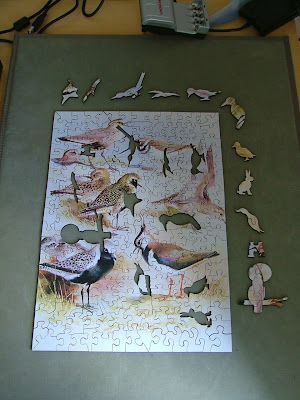
Above: The completed jigsaw with all the 'whimsies' taken out & put to the side.
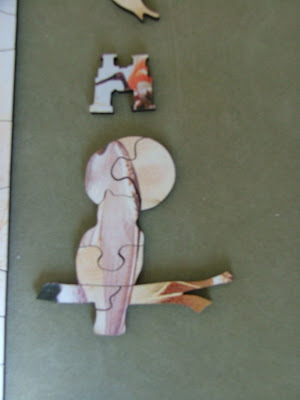
Above: 2 of the 'whimsies' - an owl sitting on a branch with the moon behind its head and a pair of binoculars!
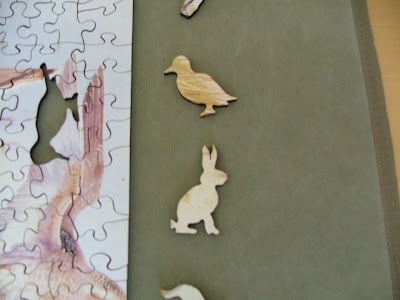
Above: I think - but I am not entirely sure on this - that all the Wentworth Jigsaws with 'whimsies' have the Wentworth Rabbit as one of them.
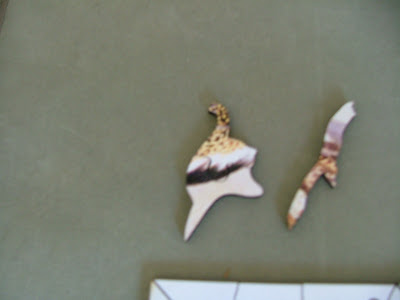
Above: 2 more 'whimsies'v- a flying bird and the head of a lapwing.
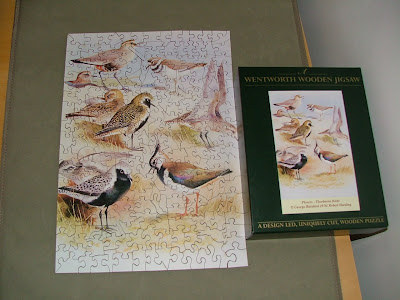
Above: The finished puzzle with box.
Above: The completed jigsaw with all the 'whimsies' taken out & put to the side.
Above: 2 of the 'whimsies' - an owl sitting on a branch with the moon behind its head and a pair of binoculars!
Above: I think - but I am not entirely sure on this - that all the Wentworth Jigsaws with 'whimsies' have the Wentworth Rabbit as one of them.
Above: 2 more 'whimsies'v- a flying bird and the head of a lapwing.
Above: The finished puzzle with box.
Saturday 14 June 2008
Swan 14/06/08
It's my Tern
This weekend should tern (ha ha ha) out to be very interesting one! I forget which species of bird I first ringed, but a Common Tern chick was one of the first. The first bird I ever held in the hand was a Reed Bunting.
Today, 14th June 2008 I was out at a local country park where we took a boat out to the island. This is the same island that we ringed Herons & Cormorants back in March. There is a Tern platform at the end of the island. Here is what we found (Common Tern chicks & eggs):
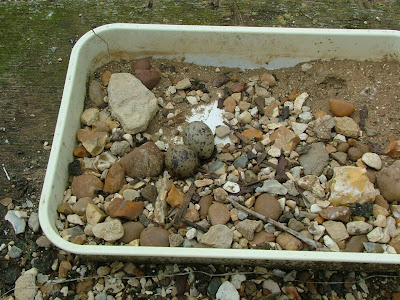
Above: Two eggs amongst the gravel (put there because Tern's like nesting in gravel
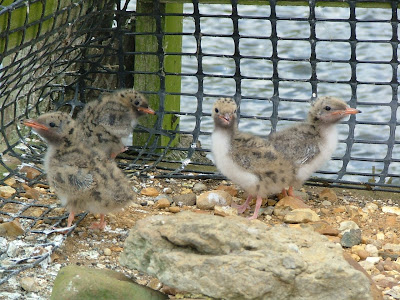
Above: 4 common tern chicks (there were 7 in total + several eggs). Their mottled colour (seen from above by predators) helps them blend in with the stones/pebbles that are their normal nesting sites.

Above: Standing tall and proud, staring possible danger (why would they know we mean no harm) straight in the face! Defiant.
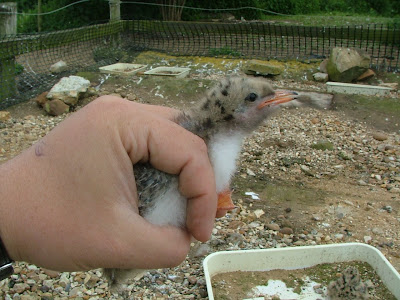
Above: I am holding one of the little darlings in my hand.

Above: The smallest one is in danger, crouching, near the edge of the platform. I rescued it and made sure it was safe before we left.
Tomorrow should be full of gulls! I am going to a local gravel pit to ring (hopefully) some new species that sould include a Black Headed Gull. More to follow.
Today, 14th June 2008 I was out at a local country park where we took a boat out to the island. This is the same island that we ringed Herons & Cormorants back in March. There is a Tern platform at the end of the island. Here is what we found (Common Tern chicks & eggs):
Above: Two eggs amongst the gravel (put there because Tern's like nesting in gravel
Above: 4 common tern chicks (there were 7 in total + several eggs). Their mottled colour (seen from above by predators) helps them blend in with the stones/pebbles that are their normal nesting sites.
Above: Standing tall and proud, staring possible danger (why would they know we mean no harm) straight in the face! Defiant.
Above: I am holding one of the little darlings in my hand.
Above: The smallest one is in danger, crouching, near the edge of the platform. I rescued it and made sure it was safe before we left.
Tomorrow should be full of gulls! I am going to a local gravel pit to ring (hopefully) some new species that sould include a Black Headed Gull. More to follow.
Friday 13th June 2008
Unlucky for some, but I had a great day! Earlier on in the week I ringed my first Garden Warbler (GarWa - ringing terminology). Well I've now ringed my second GarWa. My trainer would say that it's quite a boring bird really (Scientific name Sylvia borin), but I would say that it's just your ordinary garden variety LBJ (little brown job). There are many (and I mean many) types of Warbler to get confused with and without going into detail, the GarWa is chunkier than most others.
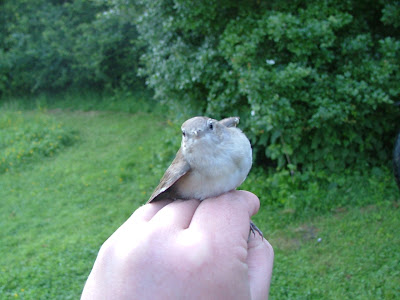
Above: The GarWa in my hand! I let it go soon afterwards, job done ... until next time we - or maybe somebody else catches it :o)
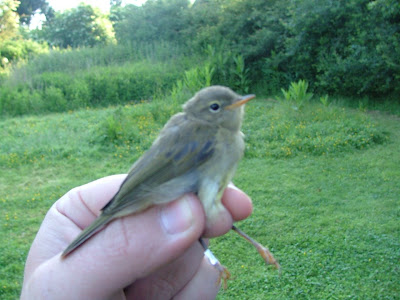
Above: A juvenile Chiff Chaff with a shiny new ring on. These rings are very light weight so as not to affect their survival.

Above: A fist full of chiffs. All 3 juvenile Chiff Chaffs (including the one photographed above) caught in the same part and same side of the nets therefore all were from the same brood. 2 more new juveniles were caught later on in the morning.
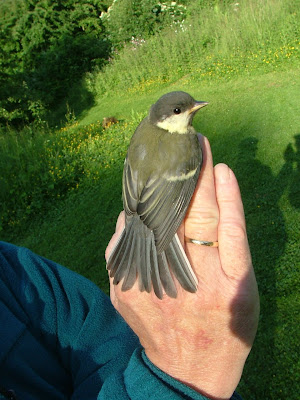
Above: A juvenile Great Tit. Please note the yellow cheek panel. This indicates a juvenile - adults would have a white cheek panel. This bird was a retrap - i.e. it already had a ring on it. We hadn't caught this one in the nets before, so where did the ring come from? It was one of our rings. In fact, I think I remeber having seen this bird before. Puzzled yet? I'm not - it came from bird box number 3 (we ringed the juveniles while in the nest box). If you would like to see nest box number 3 (and the brood of Great Tits inside) look at my first ever post on this site 21/05/08! I have no way of knowing whether the Great Tit being ringed by my trainer (Errol) is the same one as in the above photo (would be a nice coincidence though!).
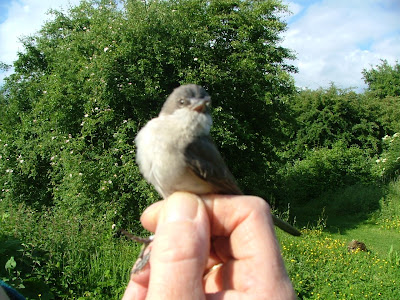
Above: The best bird of the day! A Lesser Whitethroat (LW). As with the GarWa, this is only the second LW I have ever ringed (first one being nearly 2 years ago in Gloucester). It was a very 'tatty' male - i.e. he was working very hard to keep himself, his mate & probably some juveniles fed. And all this after travelling thousands of miles to get here!
Above: The GarWa in my hand! I let it go soon afterwards, job done ... until next time we - or maybe somebody else catches it :o)
Above: A juvenile Chiff Chaff with a shiny new ring on. These rings are very light weight so as not to affect their survival.
Above: A fist full of chiffs. All 3 juvenile Chiff Chaffs (including the one photographed above) caught in the same part and same side of the nets therefore all were from the same brood. 2 more new juveniles were caught later on in the morning.
Above: A juvenile Great Tit. Please note the yellow cheek panel. This indicates a juvenile - adults would have a white cheek panel. This bird was a retrap - i.e. it already had a ring on it. We hadn't caught this one in the nets before, so where did the ring come from? It was one of our rings. In fact, I think I remeber having seen this bird before. Puzzled yet? I'm not - it came from bird box number 3 (we ringed the juveniles while in the nest box). If you would like to see nest box number 3 (and the brood of Great Tits inside) look at my first ever post on this site 21/05/08! I have no way of knowing whether the Great Tit being ringed by my trainer (Errol) is the same one as in the above photo (would be a nice coincidence though!).
Above: The best bird of the day! A Lesser Whitethroat (LW). As with the GarWa, this is only the second LW I have ever ringed (first one being nearly 2 years ago in Gloucester). It was a very 'tatty' male - i.e. he was working very hard to keep himself, his mate & probably some juveniles fed. And all this after travelling thousands of miles to get here!
Subscribe to:
Posts (Atom)
